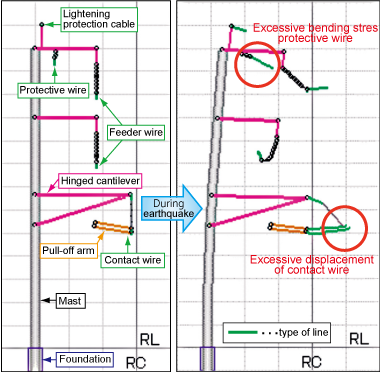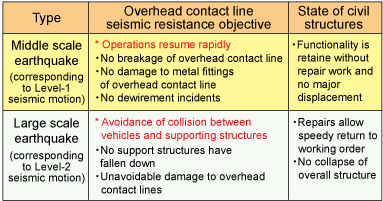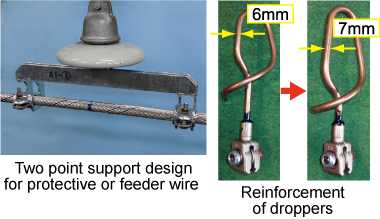4. A measure for raising seismic resistance and performing 3-D dynamic analysis of overhead contact lines
- A 3-D dynamic simulation of overhead contact lines, other electric wires such as feeder wires, metal fittings, and masts supporting them. This was employed to understand the behaviour of different parts of the overhead contact line system and identify weak points.
- Prototype countermeasure products to remedy vulnerable points in the overhead contact line system were made, and checks were carried out to confirm an improvement in seismic resistance.
Even though civil structures such as viaducts and bridges may not suffer severely in the case of middle scale earthquakes (corresponding to Level-1 seismic motion), overhead line system components can be damaged such as pull-off arms breaking or AT protection wires rupturing, which in turn seriously affects train operations. As such, effective damage prevention countermeasures were investigated.
The structural components of the catenary system were modelled in order to be able to reproduce their behaviour in 3-D, and simulate the movement of structural elements under seismic conditions (Fig. 1). In the present simulation, earthquake displacement was input into the foundation of a mast. The response, in the form of stress and load etc. is calculated in the elastic region. This was compared with the tensile strength and fracture load of each structural member to assess safety. By way of example, weak points on a selection of overhead contact line system structures typically found on Shinkansen lines were pinpointed. The minimum strength to be demonstrated and necessary structure for each of the selected components were then studied with a view to meeting the middle scale earthquake objective of speedily resuming operations (Table 1). Based on the above, the basic performance and strength etc. of the prototype metal fittings and droppers inter alia were verified, before recommending them as countermeasure products (Fig. 2).
This method is an efficient way of performing a series of tasks such as determining seismically vulnerable spots in overhead contact line systems and verifying the suitability and effectiveness of implementing various countermeasures. Furthermore, this process can be utilized to analyze microtremors in masts associated with vibrations from viaducts or other structures, generated by passing trains.
 Fig. 1 Example of 3-D dynamic simulation of the overhead contact line system
Fig. 1 Example of 3-D dynamic simulation of the overhead contact line system- Table 1Objectives by seismic magnitude

 Fig. 2 Anti-seismic reinforcement measure proposals
Fig. 2 Anti-seismic reinforcement measure proposals